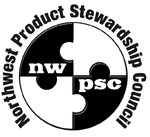Product stewardship
Product stewardship is an environmental management strategy that is based on the principal that whoever designs, produces, sells or uses a product takes responsibility for minimizing the product’s environmental impact throughout all stages of the product’s life cycle. The greatest responsibility lies with whoever has the greatest ability to affect the life-cycle environmental impacts of the product.
The Solid Waste Division (SWD) promotes product stewardship in order to:
- Reduce local government’s waste disposal costs by sharing the responsibility for managing certain wastes with manufacturers, retailers and consumers
- Reduce the use of toxic materials in products
- Conserve resources by encouraging reuse and recycling through good product design
In an era when local government resources are limited, product stewardship provides a way to reduce the potential cost to ratepayers by placing more responsibility on manufacturers to design products that can be disassembled for recycling, are less toxic, and give some forethought to how products should be collected and managed in a way that conserves valuable resources.
Product stewardship strategies are part of the county’s 2001 Comprehensive Solid Waste Management Plan. At the direction of the King County Council and the Regional Policy Committee, a report entitled King County Product Stewardship and Strategies Download PDF , 4.4 MB was developed in June of 2002. The report provides background information on product stewardship policies, an explanation of how target products and materials are selected and a summary of the partnerships that the SWD has formed.
Northwest product stewardship council
SWD is a member of the Northwest Product Stewardship Council external link , a group of government organizations that works with businesses, government agencies and nonprofit groups to integrate product stewardship principles into the policy and economic structures of the Pacific Northwest.
The goal of the council is to leverage limited local government resources to bring regional product stewardship programs and policies to the Northwest.
SWD is also a member of the Product Stewardship Institute external link (PSI). PSI is a national organization that works with state and local government agencies to partner with manufacturers, retailers, environmental groups, federal agencies and other key stakeholders to reduce the health and environmental impacts of consumer products. Currently, 33 states and more than 100 local agencies are members of PSI.
Examples of product stewardship
The take it back network
The network is a program developed by SWD to stimulate private-sector involvement in recycling used electronic equipment, lamps that contain mercury, and mattresses. Members of the network are private businesses and nonprofit organizations that accept mattresses, used fluorescent light bulbs and tubes, or electronic equipment for reuse or recycling. By stimulating these recycling industries, jobs are created in the private sector and consumers are provided with convenient drop-off sites for their unwanted electronic equipment, spent fluorescent lamps, and used mattresses. The program eliminates the need for the county to provide collection at its transfer stations and reduces the county’s operating costs.
Regional product stewardship programs
E-Cycle Washington
In 2006, Washington State passed landmark legislation requiring that manufacturers of computers, monitors and TVs provide recycling services free of charge to Washington residents, schools, small businesses, small governments, and charities. This law ensures that these electronic products, which contain toxic materials like lead, cadmium, and mercury, are properly handled and valuable resources are recycled and reused.
The new recycling program resulting from this law is called E-Cycle Washington external link . The program launched in January 2009 and collected approximately 38.5 million pounds in the first year of the program. Local governments provided publicity about the program while electronics manufacturers funded the collection, transportation and recycling of the products. As of 2013, there were 330 E-Cycle collection sites in Washington, 200 million pounds of electronics Download PDF , 981 K were turned in for recycling and 13 million pounds of lead were kept out of landfills, incinerators and our environment. The Seattle Times Editorial Board stated that E-Cycle Washington was a smash hit external link .
Mercury-Containing Lamp Recycling Law: LightRecycle Washington
In 2010, Washington State passed legislation, Chapter 70.275 RCW external link , that requires manufacturers of mercury-containing lamps to contribute funding to a statewide recycling program for mercury-containing lamps including fluorescent bulbs and tubes. The product stewardship program's external link implementation was delayed but began January 1, 2015 as LightRecycle Washington external link .


 Translate
Translate

